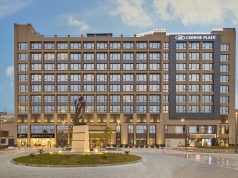By: Mariam Elhamy
Darb 1718 has been around since 2008, serving as a cultural center, art gallery, and a space for anyone who wants to be discovered or show their art to the people. Founder Moataz Nasr is buzzing with excitement ahead of Something Else Off Biennale’s launch this week, and we caught up with him to get all the details on what this momentous event will have in store!
Tell us about Something Else Off Biennale, how will it be different this year?
The idea behind “Something Else” is doing an “Off” Biennale in Cairo for a Biennale that doesn’t exist anymore. Cairo Biennale stopped in December 2010, due to money issues. So we started this thing with no money! I knew a few artists and curators in different countries and I got in touch saying “we need you here in Egypt”, I found everyone super helpful and excited about the idea. Due to this success story, it was recently announced that Biennale Cairo will reopen in April 2019.
This year we will have artists joining us from 26 countries. When we did the first edition we weren’t as experienced in planning an event of this scale, so this year it’s better prepared. The theme of this Biennale is “what if?”, an idea which opens your imagination to so many possibilities with different outcomes to what is now history … so what if?
The concept of street art is very interesting, how is this concept developing in Egypt?
Street art is growing greatly in Egypt, especially after the revolution. Many artists came out and added their work to the art scene. We try to help by providing the space for these artists to develop their art and take it to the next level. With time, when people start to understand the importance of street art, these artists will have a better chance of success.
Art is a very diverse topic; how do you separate your own preference from what is exhibited at Darb 1718?
I don’t. What is exhibited in Darb is what I see is art, I turn down a lot of artwork that isn’t up to that standard. Some people rent the space to show their own projects, and they are completely responsible for it, so it is not directly affiliated with Darb.
On a personal note, how did your love for the arts begin?
It started back in my childhood at home. My mother used to produce oil paintings and I would sit on the couch and watch her paint for hours. Later, I began painting myself and I was “the artist” among my friends in school.
How do you find Egyptian art different from other countries you have visited?
It’s different in the heaviness of the work itself because Egypt has seen a lot of struggle in the past few years and this shows in its art. Any artwork in Egypt is vastly affected by the toughness of life and the battles that we all go through every day, compared to other countries which have lighter, simpler, and more tender art. No one can escape politics and its consequences in art, it just shows in the work. This makes Egyptian art very different and unique.
Darb 1718 has a unique position and significance on the Cairene art scene, to encourage young talent, how do you select who gets to display their work or play their music?
Darb’s mission is spreading culture, that’s what we devote our time and energy to; to stand by and encourage the cultural artisan part of life in Egypt. I’d say that we are willing to show all kinds of art, whether drawing, painting, photography, sculpting, videography, performance, singing, playing music, dancing, or theater. We don’t have any restrictions as long as the artist believes and fights for their idea, the artist has to convince us that their work is worth it.
How did you discover Kasr El Sham3 Street Al Fakhareen, the spot where Darb 1718 is located?
This location discovered me! 25 years ago, I used to come here as an artist way back when it was just a local area. I fell in love with it immediately and I built my studio here, then it grew to become Darb 1718 and with it, my dreams grew as well.
How do you raise awareness campaigns and cultivate the Egyptian mindset through Darb 1718?
Through the many campaigns, programs and workshops that we do. For example, we’ve done a campaign about sexual harassment and two exhibitions about the bread crisis, as well as two exhibitions called Maspero 1 and Maspero 2, which unveiled certain ugly truths. We are the pulse of society; we speak up through art with what the society wants to say, but can’t.
Is it challenging to constantly be on the hunt for new young talented individuals worth promoting?
There are so many great talents everywhere you look, and even though it’s hard finding ones that are worthy, it’s also very beautiful. The second best feeling ever, after personal success, is helping someone else succeed. 10 years ago I was being interviewed by a journalist and while we were talking he was doodling in his notebook, so I asked to see what he had drawn. I discovered his talent by mere coincidence and offered him an exhibition here at Darb. He’s now a very successful artist in the United States. It’s an amazing feeling helping people discover their talents.
Did you encounter any bureaucratic hurdles when you were establishing Darb? How did you overcome these challenges?
Bureaucracy is endless, this place was shut down a few times in the beginning and we reopened, so yes, we definitely had to deal with a few struggles in the beginning and even until now.





